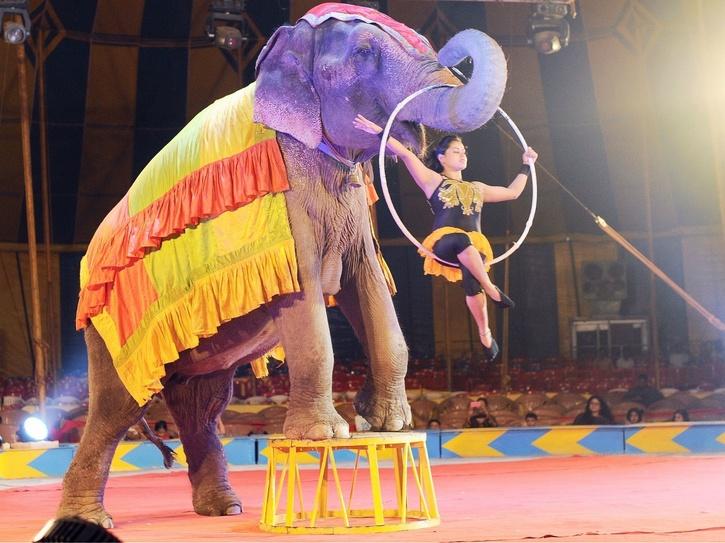Elephants in Entertainment
Circus Elephants
Tourism companies and circuses house multiple elephants in spaces that are a fraction of size of vast forests that these animals need to freely roam in. These animals are also then further "trained" (using physical violence) to perform tricks and stunts, continuing the abuse they experienced during their domestication.
Elephants are used in Safari or hunting tourism, where tourists are taken into forests on elephants' backs to watch/hunt.
There are also individual elephant owners that make a living by giving tourists rides on the elephant's back. All of which cause indirect participation in elephant cruelty by creating a demand for elephants.


Elephants in Cultural Tourism
In the name of propagating and championing culture and tradition, many organizations offer elephant rides, interactions with elephants, parades, etc. These organizations are often customers of elephant training schools — they buy domesticated elephants from these training schools — and thus indirectly and tacitly end up supporting the abuse of elephants.


Elephants in Ecotourism
There are different kinds of ecotourism, pertaining to elephants:
- Jungle safaris: these take people in vehicles into jungles to view elephants in their natural surroundings. This is good and educational. We learn how elephants thrive in the wild, the structure of their families, etc.
- Elephant sanctuaries: these house elephants that their previous owners have decided to return to forests. But, due
to prolonged confinement by humans, these elephants
are not used to fending for themselves and need to be hand-fed for some time, before being released back to
the forests. The sanctuaries help do this. When the elephants are in the sanctuaries, the sanctuaries allow visitors
to view the elephants. This is laudable.
But, a sanctuary has the potential to degenerate into an elephant viewing centre (see below). This does happen often and causes the organization to unnecessarily prolong the elephants' stay at the sanctuary and thus delay their release into the forest, or even obtain new domesticated elephants from elephant schools (training camps) to replace/augment any released elephants.
- Elephant viewing centres: these house several captive, domesticated elephants offering viewing and elephant rides for visitors. The elephants are purchased from elephant training schools or elephant markets and the entire focus is on generating revenue using elephants as the product.
Health Hazards
Elephants are not created by nature to carry large loads on their backs. We don't see elephants in the wild carrying their young on their backs, do we? Habitually forcing an elephant to carry loads puts continuous pressure on its spine and damages and weakens its backbone, making it sag.
In the photo below, the elephant of the right is a forest elephant and looks as a healthy elephant should. The one of the left is an elephant forced to carry a platform full of tourists and a mahout, causing its back to sag.

